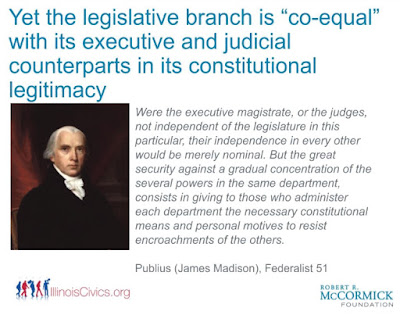Understanding How the Government Works: Separation of Powers
by Mary Ellen Daneels, Civics Instructional Specialist
From the award-winning musical Hamilton to current events involving the upcoming elections and government response to COVID-19, essential questions surrounding the separation of powers loom large in political discourse.
- To what extent are the branches balanced?
- Who has power and why?
- To what extent have Constitutional structures been successful in limiting the risk of tyranny?
- Is a strong president in the best interests of the nation?
- To what extent should the executive and judicial branches be involved in creating public policy?
- How do competing interests influence how power is distributed and exercised?
- To what extent is the judiciary political?
- Does the system of checks and balances provide us with an effective and efficient government?
If you missed the webinar, you can access the recording to deepen your content knowledge and get connected resources and strategies for teaching about separation of powers in your classroom.
At the end of each webinar, our Illinois Civics Instructional Coaches share resources aligned to the proven practices of civic education embedded in both the middle and high school civics course requirements. This week, two coaches shared tools they encourage teachers to begin with to enhance their current instruction around the separation of powers.
- Dr. Bonnie Laughline-Schultz from Charleston would start with resources from iCivics. “iCivics has a great simulation called Separation of Powers: What’s for Lunch? that would be great for use with middle-level students. It helps students see the separate powers that the three branches have and how they check each other — first, they work through a fun role-playing exercise about choosing a lunch menu, and then they see how this relates to our government.
- Chris Johnson from Oneida encouraged educators to use a tool like the Interactive Constitution from the National Constitution Center. “I say you go to the source of this all: the Constitution itself. Article I presents the list of powers given to Congress, dive in there! Use the Interactive Constitution to let students dive into these powers. Connect these powers to events today.
- COVID testing and rules: Which branch of government can make masks mandatory? What about the opening/closing of businesses? How can the other branches act if these rules are too extreme or unfair? (Note both Illinois, Iowa, and Wisconsin have great examples to use here for checks and balances)
- Gun laws and regulations: What limits the sale of licenses for gun ownership can the legislative branch make? What happens if those laws are too extreme? How can the other branches of government check the power of the legislative branch?
- War: What are the roles of the executive and legislative branches in war? Who declares it? Who leads the military? How does the Constitution balance war powers between the executive and the legislative branches?
- A Curriculum Design Toolkit with resources to help you identify assets in your curriculum and resources to meet any needs for civics course implementation, including strategies for direct instruction on limited government.
- Lesson plans aligned with the Illinois Social Science standards and proven practices of civic education that explore constitutional concepts like limited government, federalism, separation of powers, checks and balances, and judicial review.
- Guidelines for Administrators that describe how the Illinois Civics mandates align with other educational initiatives.
What are you doing to implement the middle and high school civics requirements? Please comment below. Together we can prepare ALL students for college, career, and civic life.





Comments
Post a Comment